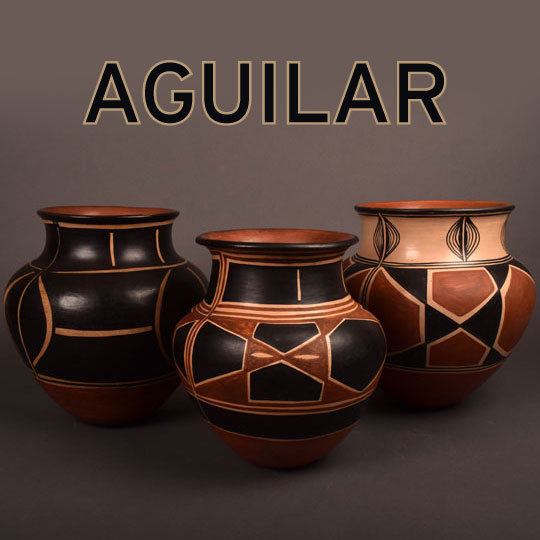Adobe Gallery Blog
Aguilar Sisters Historic Pottery of Santo Domingo Pueblo 2019
At the turn of the twentieth century, Felipita Aguilar Garcia and Asunción Aguilar Caté—sisters from Santo Domingo Pueblo—were creating pottery in the traditional fashion of their people. The Aguilar sisters were skilled potters who produced fine examples of traditional Santo Domingo Black-on-cream pottery. At the time, the Santa Fe train stopped at Santo Domingo Pueblo, allowing the sisters and other Native artists to sell their works to visitors.
By 1910, the Aguilar sisters’ pottery sales had decreased significantly. They sought counsel from trader Julius Seligman, who was aware of their declining sales. Seligman suggested that they develop new designs. His specific suggestion was that they use more red than they had in the past. The Aguilar sisters accepted Seligman’s advice, began experimenting, and ultimately created two distinct versions of a new style of pottery that was more bold and modern-looking than standard Santo Domingo pottery. In one version, the decorated area is black with narrow cream-colored lines forming strong geometric patterns. In the other, the designs are of the same type, but in red and black with cream-colored outlines.
Most of the Aguilar sisters’ creations were water jars (or “tinajas”) and storage jars. It is known that they also produced bowls—a photograph dated 1912 shows a large Aguilar sisters dough bowl or large storage jar on a library table in the lobby of Lamy, New Mexico’s El Ortiz Hotel. (Taylor, 1987:220)
Seligman stocked his shelves with their new works, but there is no indication that sales increased. Their movement was strong but short-lived. It seems to have ended around 1915, most likely because of old age or illness. There is some disagreement as to the end of their careers, however. An unpublished text by Francis Harlow and Dwight Lanmon includes a handful of pieces by the Aguilar sisters, most of which are reported to date to 1910-1915. Chapman (p.152) states that two Black-on-red jars are known to have been made by one potter as late as 1920. He does not state the name of the potter, but it can be assumed that he was referring to one of the sisters. Douglas (1941) states that the two sisters passed away around 1915. Batkin (p.99) states that “evidence suggests that Felipita Garcia continued her style as late as 1920 to 1930; she also made traditional polychrome and Black-on-red vessels, all of them beautifully executed.”
We are attributing our collection to both Felipita and Asunción, as they are generally regarded as the creators of this style. We are unable to confidently attribute a certain style to a certain sister, and so are crediting the pair for the creation of these jars. It should be noted there was likely a third potter in the family who produced similar works—many of our reference materials mention a sister-in-law. Her name is inconsistent between various texts, and so we are unable to identify her with confidence. As is often the case with pueblo history, conflicting reports exist, and precise details are unknown. It is our sincere hope that records someday will permit the attribution of specific vessels to the hands of each of the Aguilar sisters, and possibly their sister-in-law as well. For now, we cannot make attributions with any degree of confidence. What we do know is that the Aguilar sisters’ pottery, both the old and new styles, slid into obscurity, save for recognition from the scholars mentioned above. Collectors who purchased their pieces were aware of neither the names of the makers nor the story behind the creation of the style.
When viewing these jars, one might assume that they were made much later than they were. That assumption would be reasonable, as they look very modern. The Aguilar sisters created a seamless blend of old and new that has aged very well in the century that has passed since its inception. Quite simply, they were ahead of their time. Like many truly innovative creators, their efforts were not recognized until much later. Despite being largely ignored during the era of their creation, the Aguilar sisters’ jars rank among the most important pueblo pottery pieces made during the early twentieth century.
Downloadable Digital Catalog of this Show


